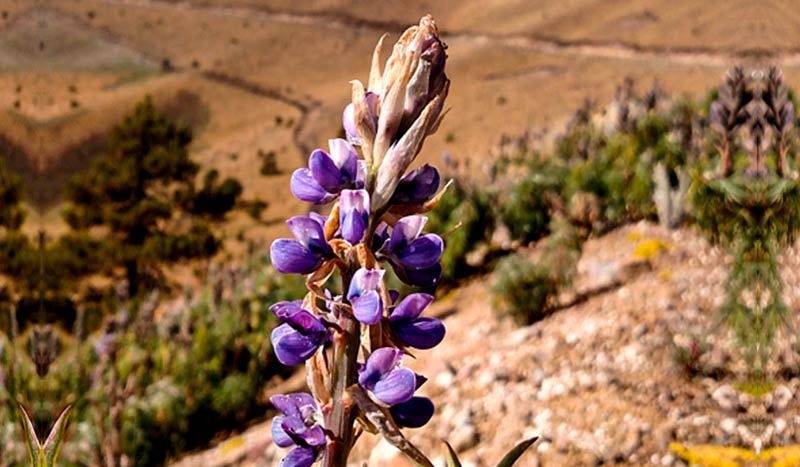
Tarwi
With the scientific name Lupinus mutabilis Sweet, it is a legume native from the South American Andes, the debittered and cooked seeds are used by Andean people of our country as food and as a medicinal plant.
Their common names are Chocho, Lupino, Lupine (Spanish), Tarwi, Tarui (Quechua), Candy stick (English), and Lupine (French).
It grows over 3,850 meters above sea level, it can be found from Venezuela to Chile. In Peru, its distribution covers the Andean and Inter-Andean areas of the Amazon, Ancash, La Libertad, in the north, Lima, Junín, in the center, Apurímac, Puno and Cusco in the South.
TRADITIONAL USES
Spanish chroniclers relate that the Incas valued in their diet the consumption of potatoes, occa, olluco, beans and Tarwi, being so important to the Inca, the Spanish imposed taxes on these foods.
Today it is known that these foods combine and provide an ideal diet, rich in essential proteins, as well as oils and minerals.
Likewise, popular knowledge presents a variety of diets with Lupinus, such as chocho ceviche, chocho spicy, chocho pepián, chocho juice combined with papaya, chocho porridge combined with orange, analyzing these diets, tubers are combined with Lupinus (As the Inca did, both potato and Lupinus), and in the case of the combination with fruits, it is ideal to take full advantage of the minerals that Lupinus presents (Iron with Lemon or orange, helps the formation of hemoglobin).
Diabetes. Raw tarwi powder is boiled without debittering until it forms a watery mass. Cooking is done with a suitable proportion of water. From this paste, a small portion is taken, the one that adheres to the tip of the spoon, having to take fasting for a month. Its property is to make the symptoms of the diabetic disappear, after it has been diagnosed by the doctor.
Kidney disease. People who suffer from kidney problems tire very quickly, suffer from pain and cramps in the waist area. To alleviate and cure these ills, the water resulting from soaking the tarwi is used. To this water, cooking salt heated in a toaster is added, this warm liquid is put on the sore part, soaking in a black cloth as encouragement. Bed rest is necessary for a complete recovery. The process should be repeated until it is well restored. It has the same effect when using water, the product of cooking the tarwi during the debittering process.
Hangover. To alleviate this process, most peaseants directly consumes the debittered tarwi grains and in a short time feels relieved.
NUTRITIONAL VALUE
The nutritional value of tarwi is variable according to the cultivars that are analyzed; however, in general its high protein content makes it an ideal food to be supplied in diets. Approximately proteins (38.9%), fat (17.1%), calories (411 cal / 100g), and alkaloids (3.5% -4.2%) that do not allow their direct consumption, having previously been eliminated.
Lupinus oils are promising for the industry, towards the projection of having a product similar to soybean oil, which for Peruvians would be lupine oil, which would contain polyunsaturated oils (oleic, linoleic and linolenic), which are beneficial for health, especially for the prevention of cardiovascular diseases.
Regarding the composition of amino acids, tarwi, being poor in tryptophan, has a high content of glutamic acid, arginine and tyrosine compared to that of other legumes such as beans.
Other important nutritional components in Lupinus are minerals, and these include metals such as Iron, Magnesium and Zinc, this is important, due to the chronic malnutrition that occurs in Peru, as it could be bet to combat it through systematic insertion of a diet rich in non-bitter Lupinus.
TAKING ADVANTAGE FROM TAWI
- NON-BITTER SEED
It can be consumed as a snack or in dishes such as the so-called Serrano ceviche, very common in the markets of Callejón de Huaylas.
The defatted, alkaloid-free grain can be used in different products, such as high-protein vegetable mixes. Used in:
- The Bush. It is a kind of salad with abundant sliced onion, tomato, lettuce and mixed with canned sardines in tomato sauce, cooked floury potato of native varieties, bread, vegetable oil, salt and hot pepper to taste.
- Tarwi Puree.The peeled grain is used, ground in a fulling mill or in the blender, then it is emptied into a pot with a dressing of ground red pepper, chopped onion, tomato, garlic, paprika and pieces of dried meat previously soaked. To thicken, add peeled and crushed boiled potatoes.
- TARWI POWDER
The chocho peeled, ground and put to dry in the sun. The taste of tarwi flour is pleasant and tastes like almonds
It can be used in entrees such as chocho a la huancaína, or in salads, chocho salpicón or in stews such as spicy potatoes with tarwi, to make flour to prepare torrejas, thicken soups, replace peanuts or in mixtures as a component of pizzas and , finally, in desserts such as mazamorra de chancaca with tarwi, apple cake with tarwi, according to the different cookbooks produced by the Ministries of Agriculture of Ecuador, Peru and Bolivia.
Using 15% in baking with excellent results due to the fat content. It has the advantage of considerably improving the protein and caloric value of the product.Usado en:
- Tarwi Torreja. The liquefied tarwi powder
is mixed with 50% wheat flour to give consistency to the dough. It is diluted
in salted water, adding chopped quinoa leaves, onion, carrot and beaten egg. It
is fried in hot oil to consume with san-cochadas potatoes.
- Tarwi Humita. Tarwi powder is mixed with cornmeal, milk, cheese, sugar, and raisins (optional). A dough is made, the same one that is molded to be placed inside wrappers of corn husks, then it is sewn in the bakery oven or stone oven or pachamanca.
- Tarwi bread. For its preparation, tarwi flour mixed with wheat flour in a ratio of 1: 5 is used. Butter, salted water and a small portion of sugar are added, then yeast dissolved in warm water is added. It is beaten until it forms a homogeneous dough, from this dough the bread rolls are molded, placing them on tins to finally bake them.
- OTHER BENEFITS
- LIQUID WASTE FROM DISCHARGING. The liquid product of the debittering is used by small farmers to combat ticks in sheep and South American camelids, it is also used as a growth regulator or fertilizer in corn, wheat, soybean and potato crops.
- ALCOHOLIC SEED EXTRACT. Preliminary experimental studies were carried out in Sudan-Africa in which they demonstrated that the alcoholic extract of the seeds of Lupinus termis had an antieczematous activity.
- In Peru, a study of the alcoholic extract and the alkaloids of the Lupinus seed was carried out to evaluate, in rabbits and rodents, if it had an anti-inflammatory effect similar to that of the African species Lupinus termis, being its positive effect as an analgesic, anti-inflammatory and antiulcer.
- FIREWOOD. The dried logs of the tarwi have been used as firewood since ancient times. The Andean people have planted tarwi to obtain firewood from the stalks, after the harvest. These stems are moved from the farm to places near the rural dwelling.
- FORAGE. Tarwi powder, mixed with quinoa by-products, are foods with a high content of nutrients that are used in the fattening process of cattle and mainly in the finishing phase. These experiences are routinely used among farmers who fatten sheep, cattle and pigs in the tarwi-producing areas.
TRADITIONAL FORM OF DEBITTERED TARWI FOR CONSUMPTION:
1.- Cooking: Boil in water for 2 to 3 hours.
2.- Let water run: In a container, put it in a stream or drought, with the water running constantly, and periodically removing the seed, for approximately 2 weeks.
INDICATIONS
Sparteine and Lupanin are some of the quinolizidine alkaloids of Lupinus, which give rise to pharmacological effects, but also to toxic effects in the central and peripheral nervous system, similar to an anticholinergic syndrome, that is why the food use of the debittered seed.
BIBLIOGRAPHIC REFERENCES
- Propiedades Nutricional y Medicinales del Tarwi o Chocho (Lupinus mutabilis Sweet). 2015.
- EL TARWI ALTERNATIVA PARA LA LUCHA CONTRA LA DESNUTRICIÓN INFANTIL. NSTITUTO NACIONAL DE INNOVACIÓN AGRARIA – INIA. Huancayo, Peru, 2015.

